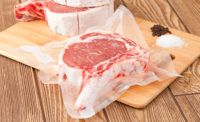Jorge Izquierdo, VP of Market Development at PMMI, discusses the emerging trends in flexible package as well as how traceability, coding and labeling is even more important considering Food Safety Modernization Act and legislation like it. Finally, editor-in-chief Andy Hanacek asks Izquierdo about the current state of sustainability efforts.
Andy Hanacek: Hi everyone, this is Andy Hanacek with The National Provisioner, and I’m here with my good friend Jorge from PMMI. Thank you again for joining me here at Pack Expo. We’re in Chicago this year, and it’s been a good show so far for us. I wanted to get some thoughts from you on some of the trends driving the packaging industry. Thanks for your time, and I’ll jump right in. Flexible Packaging [is] kind of a fast riser. A lot of the things I’ve seen in terms of trends and growth talks about flexible packaging as a fast riser among packaging types. Do you still see that to be the case, and if so, what are some of the things driving flexible packaging?
Jorge Izquierdo: First of all, thank you for joining us. It’s great to have you here. Yes, flexible packaging is still growing significantly taking market share from rigid packaging. One of the main drivers I think are certainly connected in one hand is sustainability. The amount of material you are using for flexible packaging is not the same as rigid packaging, so you are putting less packaging material into the environment, less packaging material you have to be worried about recycling. That’s on one hand. On the other hand, certainly it’s cost effective. In general, it’s cheaper to go with flexible packaging. These days with some of the techniques, the graphic techniques, flexible packaging looks great. As more years pass… this trend started several years ago and it’s holding. We are learning now more and more because of flexibility and quick changeover. In the past, the trend was let’s just have a machine that runs very fast. That’s not true anymore. Now what’s important is a machine that’s flexible and that we can switch from one product to another quickly. That’s a consequence of the SKU explosion to consumer preference. So what’s happened is, equipment for flexible packaging tends to be easier for changeover and faster for changeover.
Hanacek: Shifting gears a little bit to meat and poultry specifically. I’m sure there’s a few things, but what are some of the trends. What are some of the things you are seeing that’s driving innovation and meat and poultry packaging beyond flexible packaging that we just talked about?
Izquierdo: I would say one of the things we are finding here at Pack Expo this year. Traceability, coding, labeling is very significant. This is linked with the regulation in some cases, the Food Safety Modernization Act, but it’s also a way for brand owners to protect their products, to make sure they can keep control of their products. If there is every a problem, they can quickly address it in a clean way in terms of not pulling out of the market like a week of production of two weeks. What we are finding in terms of coding is, it’s not just your typical barcode. Of course, barcodes have been used for a long time. It’s not just about applying the barcode. It’s about linking all the information from the supplier of your raw materials of your ingredients, connecting all those suppliers, sending information to your company, sending the information down to the manufacturing floor, sharing that with the packaging line down to a specific machine, [sending it to] the coder, then linking the information to that package and back up pushing that information downstream in the distribution channel. So that’s a lot of steps in terms of machinery communication having the right hardware to do that. The second part of it is with more and more of this legislation that is being implemented, there’s a signification amount of requirements in terms of documentation, making sure the key points of your process are maintained, the equipment was cleaned properly. When you are talking about documentation and doing it by hand, it’s open for a lot of potential errors and mistakes, so more and more, it’s integrating this part of the documentation into the equipment. So it’s an active part of complying with regulations now.
Hanacek: So shifting gears one more time into sustainability, which is a broad term. But in terms of packaging materials specifically, a lot of processors and a lot of producers of suppliers of the materials have always wanted to minimize the use of the materials. Make the film thinner, or make the box smaller, or more efficient use of the cardboard. Is minimization still driving the sustainability efforts at the materials level for the suppliers of the materials as well?
Izquierdo: I would say yes, minimization is still one of the main strategies. Again, it’s putting less material into the environment. However, where there is some new materials, biodegradable materials, they are coming into the market, I would say some of them are not yet ready for primetime. This is because they don’t necessarily have the same properties as regular materials. Maybe a regular material you can run it at high speed. Biodegradable maybe you can run it at half speed or low speed. Those are still some things that need to be adjusted. Currently, minimizing is quite important for two reasons. Of course, it is sustainable for the environment, but also the cost. It’s certainly one of the main strategies. You are finding it in all different aspects of packaging. Certainly in newcomers. You have seen now they are going from all those big boxes with a lot of filling material. Now they are moving to adjusting the size of the box. So absolutely [minimization] is still the strategy.
Hanacek: Jorge, appreciate your time. As always thanks for having us out here at Pack Expo. I know you have the big ProFood Tech Show coming up in the spring as well. I think forward to attending that, seeing you there, and learning about the processing side of the business from you guys and seeing how that goes. So thank you so much.
Izquierdo: Thank you, Andy, and see you at ProFood Tech.



Report Abusive Comment